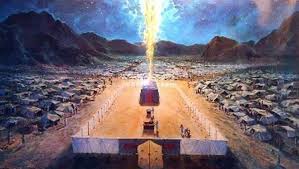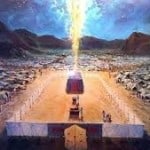We read again of instructions regarding the building of the tabernacle in the Torah portions concluding the book of Leviticus ( VaYakhel-Pekudei Exodus 35:1-40:38)
“And Moshe assembled (VaYakhel) the whole community (Adat) of the children of Israel “and he said to them: “These are the things that Hashem commanded to make.” ( Exodus 35:1).
The use of those two words-Vayakhel (assembled) and Community (Adat) is instructive
The word Adat is rooted in the concept of “Eidah “which itself originates from the word “eidut” or witnessing. It defines a community that witness and experience similar events. They are fashioned by a feeling of mutual history.
Yet the word VaYakhel originates in the concept of Kehilla. This definition describes a body of people focused on a similar purpose and destiny. This reformation of the people from a group of similar experience and history into one of mutual vision and destiny would be critical in their destiny.
After the awesome revelation of the Ten Statements, Moshe went up for forty days and descended on the 17th day of Tamuz with the Torah. He broke the tablets upon seeing the fall of the Jewish people. After forty days, he went up again for another forty-day period, finally descending on Yom Kippur, the Day of Atonement.
Yet it is then that we read the following;
“These are the things that Hashem commanded to make. Six days work will be done, but on the seventh day you shall have sanctity, a day of complete rest to Hashem; whoever performs work thereon [on this day] shall be put to death. “( Exodus 35:1-2).
After reading about the sanctity of the shabbat we then read the following regarding the building of the tabernacle;
And Moshe spoke to the entire community of the children of Israel, saying: “This is the word that Hashem has commanded to say: ‘Take from yourselves an offering for Hashem; every generous hearted person shall bring it, [namely] Hashem’s offering: gold, silver, and copper; etc ( ibid 4-5)
The Shabbat is always connected with the building of the tabernacle and that fact helps us understand what work is actually being prohibited on Shabbat. The same word for the work in building the Tabernacle, “Melacha” is the type of work prohibited on Shabbat (Shabbat 49b) . The prohibition on the Sabbath is not about simple physical work but rather about the “Creative Work “that was involved in building the tabernacle.
Yet on a deeper level, there is another connection as well. When the people are involved in the creative work of building the tabernacle, they are in essence creating a vessel for G-d’s perceived Presence in the physical realm, a spiritual oasis in space.
When they are asked to refrain from creative work on the Shabbat they are actually making room for G-d’s perceived Presence in the non-physical, a spiritual oasis in time.
Yet one needs to ask what all this has to do with Yom Kippur, the sin of the golden calf and repentance.
When the time of Yom Kippur, spent in the midst of the “awe and majesty” is over, Jewish people end their prayers with a great cry. The “Shma Yisrael” declaration is yelled out. This is followed by the crying out of the phrase “Blessed is His Name forever and ever “three times. Finally we cry out with all the strength we have left “Hashem is G-d, Hashem is G-d”, seven times.
The silence that follows that seventh cry is the silence of infinity. It could and should last forever because in that silence there is nothing but G-d. It is only the long shofar blow that brings us back down to earth.
We return home and eat something to replenish our bodies. Yet our souls yearn for more.
It is then that it begins. All throughout the neighborhoods you begin to hear the sound of hammers and of boards being raised. Everyone is out on their balconies and yards building their sukkah. Some are out buying the four species gathered together for this holiday.
Everyone is gripped with the intense desire to “do something”. Everyone is impassioned to do something for their Father in heaven. They are gripped with common purpose and desire.
After the sin of the golden calf Moshe returns to the mount. He is given another more earthly bound set of tablets. He descends with them and with the repentance that they symbolize on Yom Kippur.
It is then on the following day that Moshe is told to take this people from being an eidah into being a kehilla. To take them from being a people of common history to being a community of common purpose and destiny.
They are then given the gift of “doing” for G-d. They become involved in creating both a spiritual oasis in space and a spiritual oasis in time. That will be their true purpose and destiny until the end of time.
LeRefuat Yehudit bat Golda Yocheved

